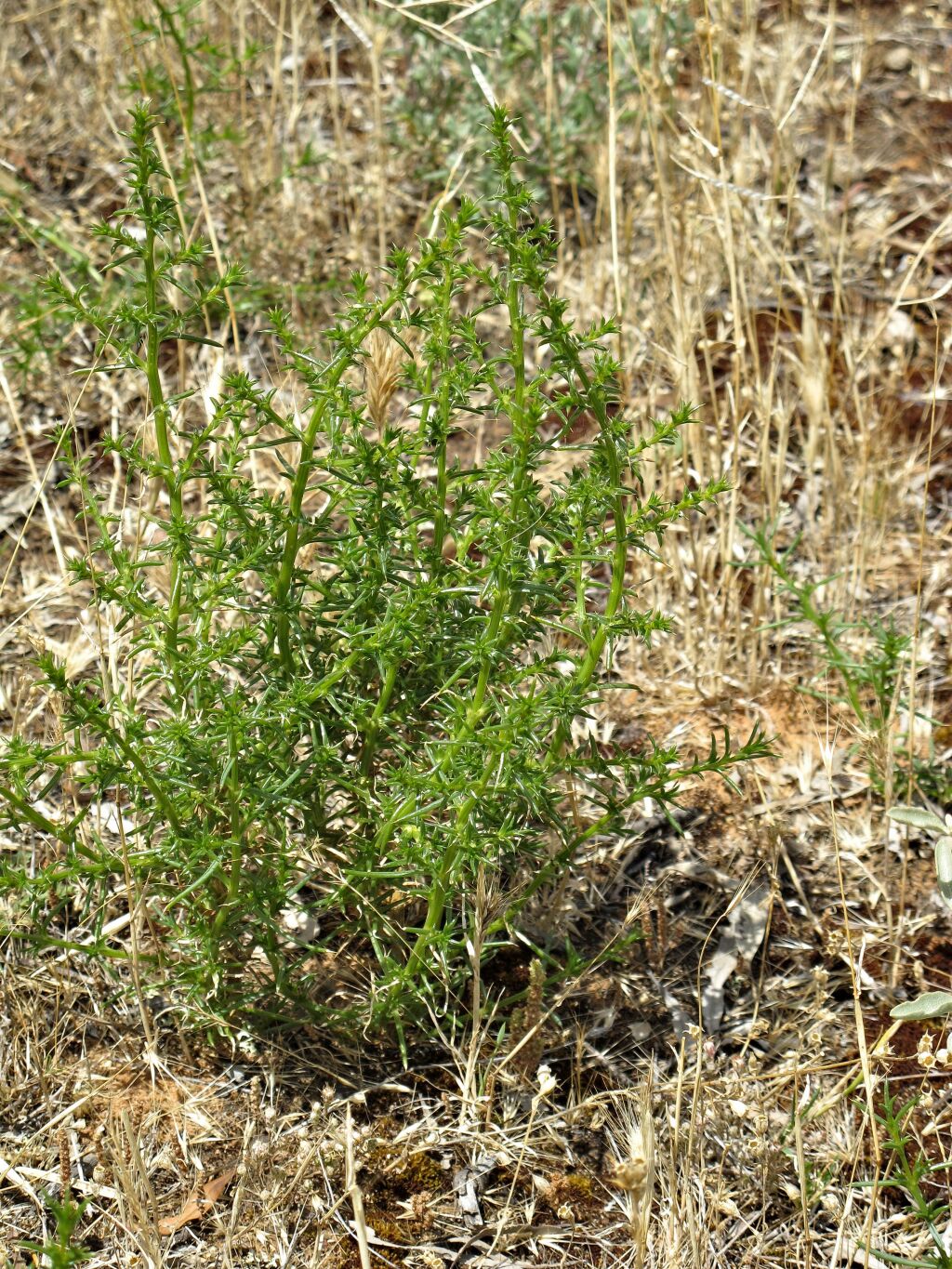Salsola tragus
L.Erect to rounded annual to c. 60 cm high (commonly breaking off near ground level at maturity and dispersing tumbleweed-fashion), glabrous, sparsely bristly or tuberculate on leaf margins and/or stems. Leaves mostly alternate, linear, subulate or triangular, 5–40 mm long, 0.5–6 mm wide, winged and shortly decurrent at base, spreading or recurved, spine-tipped, semi-terete to trigonous in section; floral leaves and bracteoles shorter and sometimes thicker than normal leaves. Flowers sessile, solitary in upper axils; perianth segments at anthesis erect, lanceolate, c. 2 mm long, membranous. Wings of fruiting perianth segments fan-shaped to semicircular, 3–5 mm wide, translucent with dark brown venation, rarely rosy pink all over, or if wings not developed then segments usually strongly thickened with a narrow transverse ridge toward base. Utricle hemispherical, truncate or depressed at summit, c. 2.5 mm diam., membranous in lower half, slightly thickened at apex. Flowers mainly May.–Oct.
LoM, MuM, Wim, Brid, VVP, VRiv, MSB, RobP, MuF, GipP, OtP, Gold, CVU, NIS, EGL, EGU, VAlp. Widespread in semi-arid, often slightly saline areas in the north and north-west, occasionally coastal (Portland, Port Phillip, Western Port), with isolated occurrences in the east (e.g. Mackillops Bridge and Mallacoota areas).
A highly variable species. Currently 2 subspecies are recognised in Victoria. A third, slender-leaved variant from the upper Snowy River area in eastern Victoria was noted by Walsh (1996). These plants were previously associated with S. kali var. leptophylla Benth. However, it is questionable whether these plants sit outside the range of variation of S. tragus subsp. tragus.
This species is now largely thought to be native in Australia. Hrusa & Gaskin (2008) suggested that Australian populations are probably endemic and not referrable to Salsola tragus, and that the name S. australis R.Br. (type from Petrel Bay, South Australia) should be adopted for Australian plants. Chinnock (2010) recognised several distinct entities within S. australis which differ morphologically and ecologically, at least two of which occur in Victoria. They are recognised here as S. tragus subsp. tragus and S. tragus subsp. pontica. If the name S. australis were to be adopted in Victoria (and elsewhere) it would leave what is currently distinguished as S. tragus subsp. pontica without a formal name, so while accepting that the placement of the Victorian plants may not ultimately prove to be correct, the names are retained here to avoid invoking ‘ephemeral’ phrase names.
Walsh, N.G. (1996). Chenopodiaceae. In: Walsh, N.G.; Entwisle, T.J., Flora of Victoria Vol. 3, Dicotyledons Winteraceae to Myrtaceae, pp. 129–199. Inkata Press, Melbourne.
 Spinning
SpinningMisapplications
Borger, C.P.D.; Scott, J.K. (2009). The biology of Australian weeds 55. Salsola australis R.Br. . *Plant Protection Quarterly * 24(4): 124–137.
Borger, C.P.D.; Yan, G.; Scott, J.K.; Walsh, M.J.; Powles, S.B. (2008). Salsola tragus or S. australis (Chenopodiaceae) in Australia - Untangling taxonomic confusion through molecular and cytological analyses. *Australian Journal of Botany * 56: 600–608.
Hrusa, G.F.; Gaskin, J.F. (2008). The Salsola tragus Complex in California (Chenopodiaceae): Characterization and Status of Salsola australis and the Autochthonous Allopolyploid Salsola ryanii sp. nov. Madrono 55(2): 113–131..


